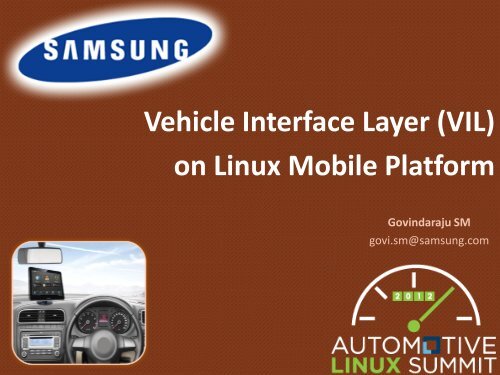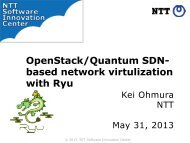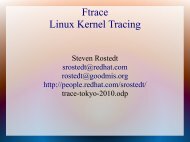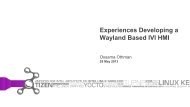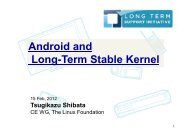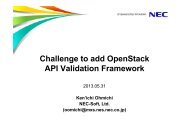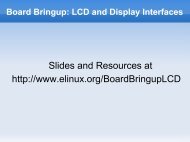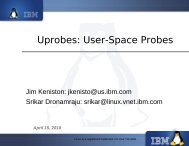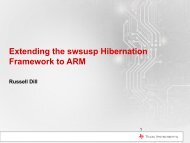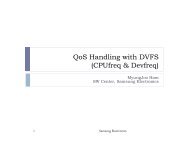Vehicle Interface Layer - The Linux Foundation
Vehicle Interface Layer - The Linux Foundation
Vehicle Interface Layer - The Linux Foundation
Create successful ePaper yourself
Turn your PDF publications into a flip-book with our unique Google optimized e-Paper software.
<strong>Vehicle</strong> <strong>Interface</strong> <strong>Layer</strong> (VIL)<br />
on <strong>Linux</strong> Mobile Platform<br />
Govindaraju SM<br />
govi.sm@samsung.com
Introduction<br />
• Mobile devices 1 have enough software,<br />
hardware and connectivity capabilities required<br />
for vehicle head unit.<br />
• <strong>Vehicle</strong> head units offers below advantages<br />
comparing with mobile devices<br />
– <strong>Vehicle</strong> bus access ( Like CAN, MOST )<br />
– External Antennas ( Like GPS, DVB )<br />
– <strong>Vehicle</strong> centric sensors<br />
– <strong>Vehicle</strong> / Driver centric UX.<br />
• Bridging these gaps through VIL can make<br />
mobile devices fully integrated mobile cum<br />
head unit device.<br />
1 Smart phones, Tablets etc…
<strong>Vehicle</strong> <strong>Interface</strong> <strong>Layer</strong> / Mobile <strong>Interface</strong> <strong>Layer</strong>
VIL / MIL<br />
• VIL exposes set of<br />
standardized automotive<br />
software service interfaces on<br />
mobile platform.<br />
• Underlying VIL <strong>Interface</strong> plugins<br />
interacts with its counter<br />
part at vehicle head unit side.<br />
• VIL transport layer provides seamless communication<br />
based on any of underlying interfaces like USB, BT,<br />
WiFi.<br />
• Mobile <strong>Interface</strong> <strong>Layer</strong> (MIL) at head unit abstracts<br />
the vehicle’s communication, software systems and<br />
provides unified interface to the mobile platform.
Head unit – Mobile <strong>Interface</strong> <strong>Layer</strong><br />
OEM Apps<br />
Trusted<br />
Downloaded Apps<br />
IVI APIs (Genivi)<br />
Un-trusted<br />
Downloaded Apps<br />
MIL<br />
Service<br />
<strong>Linux</strong><br />
IVI<br />
Stack<br />
Connectivity<br />
Sensor<br />
Stream<br />
Antenna<br />
Stream<br />
MOST<br />
CAN<br />
<strong>Layer</strong>ed View of Mobile <strong>Interface</strong> <strong>Layer</strong> on <strong>Linux</strong> IVI Stack
Mobile – <strong>Vehicle</strong> <strong>Interface</strong> <strong>Layer</strong><br />
OEM Apps<br />
Trusted<br />
Downloaded Apps<br />
Un-trusted<br />
Downloaded Apps<br />
Web APIs<br />
Native APIs<br />
Telephony<br />
Input<br />
/Touch / VR<br />
<strong>Linux</strong><br />
Mobile<br />
Stack<br />
Display/<br />
Audio<br />
Connectivity<br />
<strong>Vehicle</strong><br />
<strong>Interface</strong><br />
<strong>Layer</strong><br />
<strong>Layer</strong>ed View of <strong>Vehicle</strong> <strong>Interface</strong> <strong>Layer</strong> on <strong>Linux</strong> Mobile Stack
Access mode & Security<br />
• VIL modes<br />
– Basic: Minimal vehicle property 2 set - read mode.<br />
– Intermediate: Full vehicle property read + Limited vehicle<br />
property set - write mode.<br />
– Advanced: Full vehicle property set - read /write mode.<br />
• Sensor/Antenna stream access on all modes.<br />
• Based on DAP authentication, VIL and MIL<br />
negotiates and agree for the mode.<br />
• Mobile to Head unit authentication/Pairing.<br />
– Private mode – Own/privately used vehicle.<br />
– Public/ Rented vehicle.<br />
2<br />
<strong>Vehicle</strong> Status info
Connectivity ( Transport <strong>Layer</strong> )<br />
• Seamless usage of underlying connectivity<br />
mechanism ( USB/BT/WiFi )<br />
• Selection of access mode ( Basic, Intermediate,<br />
Advanced ) based on active connectivity<br />
mechanism and its bandwidth.<br />
• Sensor/ Antenna stream data: More accurate<br />
feed from head unit to mobile.
MIL Service <strong>Interface</strong><br />
• MIL at Head units can be customized by OEMs<br />
– Full Genivi compliance<br />
– Light weight Genivi compliance 3<br />
– Proprietary <strong>Interface</strong><br />
• VIL at mobile side interacts through appropriate<br />
plug-in<br />
– Default Genivi Plug-ins<br />
– Vendor Specific Plug-ins.<br />
3<br />
Disclaimer: Just thought process. No such thing exist as of now.
Benefits<br />
• Mobile devices computing, communication & platform<br />
capabilities are leveraged to mix with static & runtime<br />
<strong>Vehicle</strong> data.<br />
• Single personalized device: User can use single<br />
personalized mobile device for <strong>Vehicle</strong> infotainment<br />
along with normal mobile features.<br />
• Enables vehicles with basic capabilities /simple head<br />
units, to have rich vehicle infotainment solutions.<br />
• Takes advantage of frequent mobile device upgrade<br />
cycle vs. Car & Infotainment system upgrade cycle.<br />
• Downloadable Apps : <strong>Vehicle</strong> <strong>Interface</strong> can be exploited<br />
by innovative 3 rd Party Applications and provide rich<br />
vehicle experience.
Benefits - <strong>Vehicle</strong> Experience ( VX )<br />
• Enables vehicle centric User Experience<br />
development on Mobile.<br />
• Enables the mobile to change into Drive Mode<br />
and enable VX once the mobile is docked into<br />
vehicle.
Drive Mode Applications<br />
• Car control can be made safe and only required<br />
interfaces are exposed through head unit MIL<br />
Service.<br />
• Critical features are not exposed to 3 rd party<br />
applications directly.<br />
• Different application/profile configurations<br />
depends on Runtime state of vehicle (Ex: Speed)
References<br />
• OpenXC - Promoted by Ford with Android<br />
interface (http://openxcplatform.com )
Q & A


